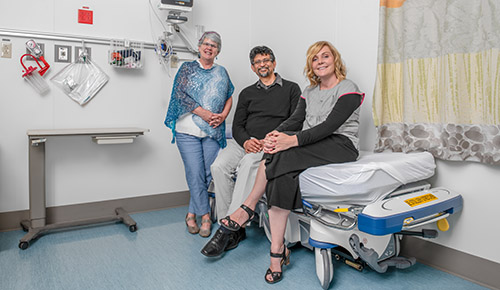
Nurse practitioner Kathy Reid, gastroenterologist Rabin Persad and psychiatrist Heidi Wilkes work together to address medical, psychiatric and mental health symptoms of patients at the Stollery Children's Hospital pediatric abdominal pain clinic.
When University of Alberta associate professor and pediatric gastroenterologist Rabin Persad was in training, he noticed a troubling pattern. Children with easily diagnosable diseases had access to treatment plans, medications and attention that those lacking a diagnosis simply weren't getting. The pediatric gastroenterologist wondered, "How do we help these children and families who are having a really hard time getting optimal treatment?" He imagined pulling together a team of health professionals, pooling their combined strengths to address the complex needs of children with abdominal pain.
The resulting abdominal pain clinic at the Stollery Children's Hospital was born about six years ago, says Persad, treating three or four patients one afternoon per month. Today, the five-person team-Persad, psychiatrist Heidi Wilkes, a nurse, dietitian, and psychiatric nurse-see up to eight patients per afternoon, twice a month. The group works closely with the Stollery Pediatric Chronic Pain Clinic, where nurse practitioner Kathy Reid, a specialist in chronic pain, co-follows many of the young patients. "There's nothing we could provide, individually, that's anywhere near as good as what we can offer as a team," says Persad. "There's so much more ability to provide family-centred, patient-centred care when we all work together," echoes Reid.
"The nice part about the abdominal pain clinic is that neither the medical symptoms nor the psychiatric, mental health symptoms are disregarded," elaborates Wilkes.
Diet, exercise and medication are key. Reid adds that it's crucial for patients missing school or activities with friends to learn behavioural strategies that can bring them out of social isolation. "For kids with chronic pain," Reid explains, "Depression is five times more common and anxiety is probably five to seven times more common." For younger children, she and the main clinic's psychologist, Bruce Dick, teach parents calming strategies to implement at home. For teens, they run group classes where patients learn relaxation strategies and mindfulness-based stress reduction while forming the kinds of healthy, supportive friendships they may have lost because of their illness.
Many families have reached the clinic as a last resort, says Wilkes. Even if children have been diagnosed with something like irritable bowel syndrome, says Persad, that diagnosis can be dismissive and patronizing. The relief is palpable when patients finally get the team's help, says Reid, when they feel someone is listening and believes them.
While Persad and his team would love to send their patients home discomfort-free, they understand that's not how it works with chronic pain. "Working in this clinic has helped me embrace ambiguity and to tolerate it a bit more," says Wilkes, and she and her colleagues know to celebrate measured victories. Says Persad, as more and more patients come in for follow-up appointments telling of decreased anxiety, higher grades and excited plans for the future, "That's just phenomenal to me; these kids have taken an amazing turn."
To help more children make that shift, Persad dreams of expanding the clinic with more staff, longer hours and new approaches such as neural stimulation for chronic pain treatment and other pharmacological and non-pharmacological methods. Until then, he and his team will continue to embrace the challenges of working with chronic pain, helping to bring a little life back, one patient at a time.